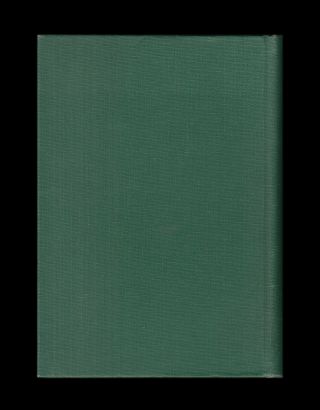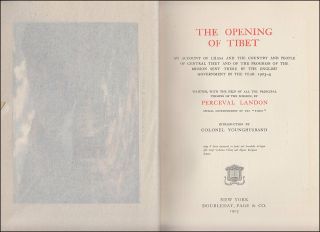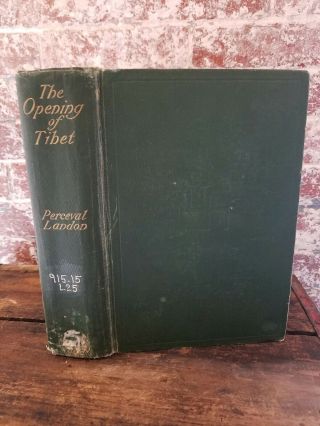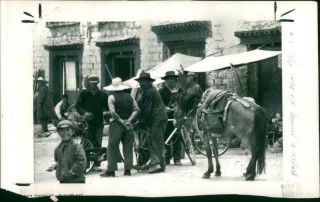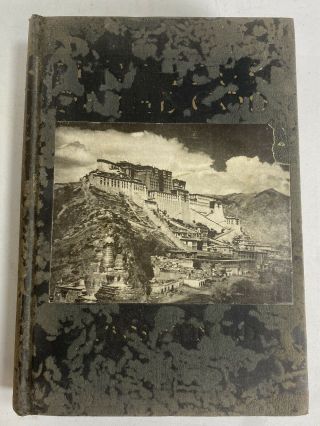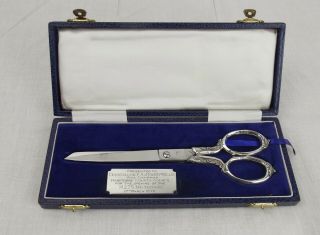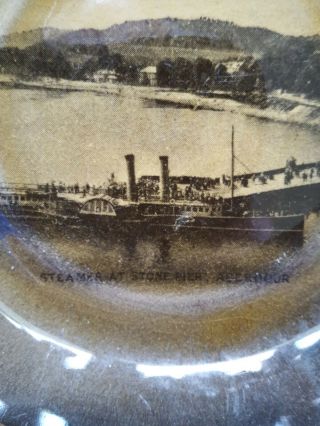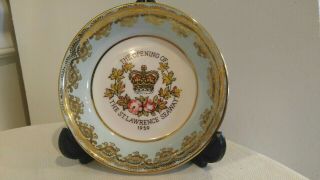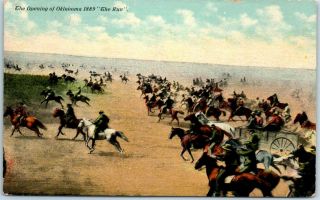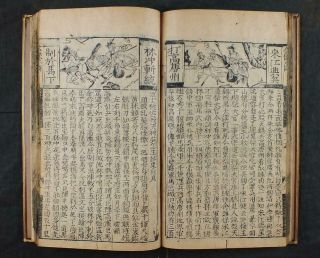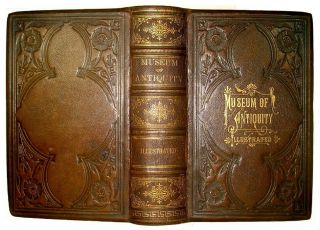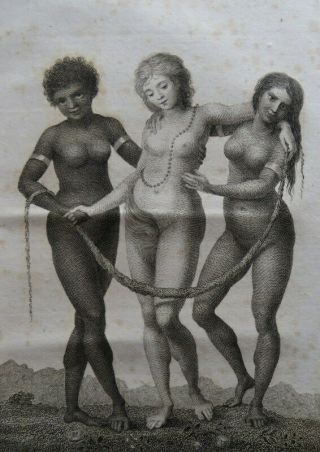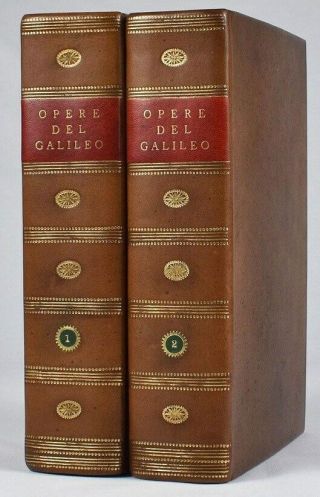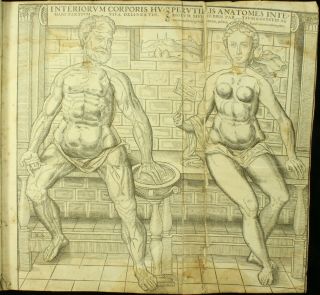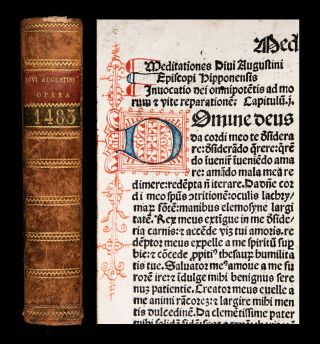Landon THE OPENING OF TIBET Lhasa, Tibetan People YOUNGHUSBAND MISSION Of 1903 - 4
Item History & Price
The Opening of Tibet An Account of Lhasa and the Country and People
of Central Tibet and of the Progress of the
Mission Sent there by the English
Government in the Year 1903-4
Written, with the help of all the Principal Persons of the Mission, by Perceval Landon Special Correspondent of the �...��Times” Introduction by Colonel Younghusband
This is the 1905 First American Edition (rebound ex-Library but clean internally) Please be aware that this is an exceptionally heavy book, making postage expensive. Please note that this book is too heavy to post to Canada.
Front cover and spine Further images of this book are shown below
Publisher and place of publication Dimensions in inches (to the nearest quarter-inch) New York: Doubleday, Page & Co. 6½ inches wide x 9¾ inches tall Edition Length 1905 First American Edition [xv] + 484 pages Condition of covers Internal condition This volume is ex-Library and has been rebound in green buckram, blocked in gilt on the spine. There is a shelf number in white ink on the spine. The spine ends and corners are slightly bumped. There are some indentations along the edges of the boards, the most prominent being in the centre of the front fore-edge. This volume is ex-Library. There are two small labels on the front pastedown and some abraded patches where other Library labels have been removed. One of the labels states that the re-binding was carried out by Hoag and Sons, Book Bindery Inc., of Springport, Michigan. There is a small tear in the frontispiece tissue-guard. Two pages (298 and 300) have small tears in the outer margin which have been repaired with tape. A few passages have been underlined in pencil or blue pencil (for example, pages 103 and 185 and page 80 which is shown below); apart from this the text is very clean throughout. There is a Library stamp on page 21. The paper has tanned noticeably with age and there are some larger areas of discolouration on the inner margins. As part of the re-binding process, the text block has been trimmed so that all edges are now uniform with the exception of pages 293-300 where there is some minor loss from the bottom corner. The colour frontispiece is a modern reproduction of the original. Dust-jacket present? Other comments No I have tried to list all the defects but, to be honest, allowing for the Library rebinding, this is a generally clean example of the 1905 American edition. Finally, this is a massive book, weighing over two kilograms when packed, making postage expensive (and too heavy to post to Canada which limits Printed Papers to a maximum of two kilograms). Illustrations, maps, etc Contents Please see below for details, but please note that the colour frontispiece is a modern reproduction of the original. Please see below for details Post & shipping information Payment options The packed weight is approximately 2250 grams.
Full shipping/postage information is provided in a panel at the end of this listing. Payment options : UK buyers: cheque (in GBP), debit card, credit card (Visa, MasterCard but not Amex), PayPal
International buyers: credit card (Visa, MasterCard but not Amex), PayPal Full payment information is provided in a panel at the end of this listing.
The Opening of Tibet Contents I - Former Explorations of Tibet
II - The Reasons for the Expedition
III - Crossing the Himalayas
IV - The Tibetans of the Chumbi Valley
V - The Fight at the Wall
VI - Forcing the Way to Gyantse
VII - Life in a Tibetan Town
VIII - Attacked by the Tibetans
IX - The Dalai Lama Shows His Hand
X - Life in the Besieged Post
XI - Religion: Manners and Customs: Art
XII - Internal History of Lhasa 1902-4
XIII Lamaism
XIV - The Relief of the Mission
XV - The Advance to Lhasa
XVI - The Last Stage
XVII - Lhasa, I
XVIII - The Environs of Lhasa
XIX - The Potala and the Cathedral
XX - The Ride from Lhasa to India
Appendices LIST OF ILLUSTRATIONS The Turquoise Bridge in Lhasa frontispiece
A Tibetan Monk With His Prayer-Wheel
A Road in The Himalayas
Encamped Under The Shadow of The Himalayas
A Member of The Expedition
Outfitted To Cross The High Passes of The Himalayas in July
The Two Abbots of A Tibetan Monastery
Awaiting An Attack By The Tibetans
Just Before The Fight At The Wall
The Gurkha Scouts Deployed On The Hillside; The Sikhs Beginning To Disarm The Tibetans At The Further End of The Wall
A Few Minutes Later
The British Force Still Firing At The Retreating Tibetans
The Expedition Halting For The Night90
The High Priest At Gyantse92
"Who Looks Like A Saddened Falstaff"
A Valley Near Samonda
East End of The Jong, Or Fortress, At Gyantse
The Town of Gyantse
Mural Paintings in The Lamasery of Palkhor Choide
Images of Some of The Great Buddhist Teachers Worshiped By The Tibetans
in The Palkhor Choide
Gaily Bedecked Yaks Drawing A Plow
A Long-Haired Monk At His Monastery
The Window of A Hermit Cell At Nyen-Dé-Kyi-Buk
Prisoners Captured By The Mission in The Karola Fight
Examples of Tibetan-Chinese Workmanship
Specimens of Chinese-Tibetan Work in Silver
Tibetan Children Characteristically Employed in A Gyantse Street
A Tibetan Political Agent
The Ta Lama At Taski-Tse
Monks Walking On A Terrace Beneath Lines of Prayer-Flags
The Chinese Wall Across The Ammo Chu At Chorten Karpo
The Mountains That Surround Lhasa
Chak-Sam Monastery
The March To Lhasa
The Omnipresent Prayer-Flags And Cairns Beside The Road To Exorcise Evil Spirits
The Western Gate of Lhasa
Lhasa, Dominated By The Towering Bulk of The Potala
The Amban, The Chinese Representative in Lhasa, Coming To Confer With Colonel Younghusband
The Chinese Representatives in Lhasa Meeting Colonel Younghusband For The First Time
The Amban Coming Out From Lhasa On His Way To Meet The Mission
A Street Scene in Lhasa: Near The Chinese Quarter
The Entrance To The Chinese Amban's Residence At Lhasa
Ornaments of A Tibetan Altar
A Horn Hut
The Lukang Garden
The Sacred Elephant in The Lukang Gardens in Lhasa
Tibetan Woods And Meadows Near Lhasa
The Elaborate Detail of Tibetan Architecture
in The Grounds of The Lha-Lu House, The Headquarters of The Mission in Lhasa
A Street Scene in The Wizard Community of The Na-Chung Chos- Kyong At Lhasa
A Close View of The Potala
The Mission Entering Lhasa
The Potala, The Home of The Grand Lama
The Potala At Lhasa, An Architectural Marvel
The Exterior of The Jo-Kang Temple, The Holy of Holies of All Asia
The Jo-Kang, With The Most Gorgeous Interior of All The Tibetan Temples, Has Practically No Exterior
The Great Buddha in The Holy of Holies At Lhasa
The Opening of Tibet Introduction WE of the Tibet Mission and its escort were honored with the conduct of a task which for fascination of interest could hardly be surpassed. Few, if any, of us doubted the wisdom of the great and far-seeing statesman who initiated the enterprise and inspired it throughout. But, whether the policy was wise or unwise, we determined that it should not suffer in the execution. On us, we felt, were fixed the eyes of many millions, not in India alone, nor in England alone, but all over Europe and America also, and in many an Asiatic country besides.
We who work in India know what prestige means. Throughout the expedition we felt that our national honor was at stake, and down to the latest-joined sepoy we bent ourselves to uphold and raise higher the dignity of our Sovereign and the good name of our country: to show that not even the rigors of a Tibetan winter nor the obstinacy and procrastination of the two most stolid nations in the world could deter us from our purpose; above all, to try to effect that purpose without resorting to force. If, as unfortunately proved to be the case, fighting were inevitable, we were determined still to show moderation in the hour of victory, and to let the ignorant Tibetan leaders see that we would respect them as we demanded they should respect us, and, in place of distrust, to establish a confidence between us which would prove the surest foundation for future relations.
A loss of life was indeed necessitated which every one of us regretted; yet I for one believe that at any rate some good will come to the Tibetans as the result of our work. War does not always mean oppression. Nor does the breaking of the power of a despotic Government mean the down-treading of the people.
From the first the Tibetan peasantry showed good-will toward us. They were especially anxious to trade--no keener traders could be found. We have, as one result, partially freed the people from the terrible incubus of priestly control, and there are unmistakable signs that we left them better disposed toward us after our advance to Lhasa than they were before. Owing to the magnificent behavior of the troops, the confidence of the people was entirely gained. Villagers and traders thronged to our camps. Soldiers went about unmolested in every part of the Lhasa bazaar. Officers were admitted to the most sacred shrines. Captain O'Connor, my right-hand man in dealing with the Tibetans, was received not only with real ceremony, but with real warmth, by the Tashi Lama at Shigatse. And, last but by no means least, Tibetan wool-merchants are already making arrangements for trading with India.
How all this was effected none can tell better than Mr. Landon. He reveled in the mysteries of Tibet, and appreciated to the full the wonderful scenery which to my mind was infinitely the most fascinating of all our experiences. I have not had the advantage of reading the proofs of his book, and I cannot be responsible for any political views which he may have expressed. But I feel confident that no more competent chronicler of what the Tibet Mission saw and did could be found, and we were indeed fortunate in having with us one of his enthusiasm and powers of description.
F. E. YOUNGHUSBAND.
LONDON,
December, 1904.
The Opening of Tibet Attacked by the Tibetans COLONEL YOUNGHUSBAND occupied Chang-lo on the 19th of April with a force of about four hundred and fifty men. He had also about fifty mounted infantry, two Maxims, and two ancient seven-pounder field-pieces, now officially discarded, which, in their popular nicknames "Bubble and Squeak, " were at once described and appraised. This force was amply sufficient to defend the place against any attack that the Tibetans could deliver. They, however, seemed in no way willing to test the defensibility of Chang-lo; and nothing could have been more peaceful than the reception of the British force, not at Gyantse only, but for a score of miles up and down the valley. It is true, that for our expeditions beyond the immediate neighborhood of the post, two or three mounted infantry were always taken as an escort, but we imagined no danger, and nothing seemed less probable than that which actually occurred. I am quite certain that the events of the 5th of May were not less surprising--and a great deal more dismaying--to the good people of Gyantse than they were to ourselves. in the last chapter I have described one or two visits paid somewhat far afield in the Nyang chu Valley, and it will be clear that nothing could have exceeded the hospitality and, in most cases, the welcome which we received. At Gyantse itself, the friendliness of the inhabitants was almost excessive. We afterward found that from the date of our expedition till the 4th of May, the servants of the Mission (who were unavoidably under less strict military surveillance than other followers) not infrequently spent the entire night within the town enjoying themselves among their Tibetan kin, with results on the following morning which were more natural than edifying. It need not be said that as soon as this was discovered the military authorities made a severe example of the chief offenders. Shopping in Gyantse was an almost daily amusement. The great Palkhor-choide monastery was willingly opened to us by the abbot, and the members of the Mission looked forward to a pleasant two months' stay in one of the most interesting cities of Tibet, and a full enjoyment of the extraordinary opportunities which the undisguised friendliness of our neighbors promised.
More than this, Captain Walton, the surgeon and natural history expert attached to the Mission, had invited the Tibetans to make the fullest use of his own skill and the medical equipment of the Mission; and, as a result, he soon had as many cases as he could deal with. By preference he selected cases requiring surgical treatment, and many unfortunate wretches disabled by cataract or disfigured by a particularly hideous form of hare-lip, which is common in Tibet, were relieved by him.
Everything was peaceful. There was not a cloud on the horizon. The dak ran through from the Chumbi Valley without interruption, day after day. The British intruders had given commissions freely in the town, and the local artists were working overtime to execute orders for "tang-kas." Carpenters from Pala attended daily in the compound and worked from morn to night upon the furniture needed for the post. Their use of tools, by the way, which seemed in most cases to be of European origin, was extremely quick and certain, and the work which the adze was made to do would have surprised the British carpenter. Planes, saws, bradawls, and, in rare cases, chisels, were also used; but nothing showed originality or suggested any device that might possibly be used to advantage at home except a little machine, simple, ingenious, and compact, for marking a straight line upon wood by means of a thread loaded with black pigment.
Gardeners also were called in, and the courtyard in front of the Commissioner's tent was carefully dug up, divided into beds, and manured. There the seeds which the Mission had brought from home were hopefully planted, and beans, peas, cabbages, scarlet-runners, onions, and mustard-and-cress were sown with an almost religious care--in return for which, it must be confessed that only the last-mentioned vegetables produced any return. Still, the experiment was well worth making, and, incidentally, it had the effect of laying the dust in the compound--by no means a slight blessing. To tend this garden a worthy Tibetan lady, with her two husbands, was hired; and if her treatment of her brother-spouses was characteristic of Tibetan domesticity as a whole there is perhaps more to be said for this strange custom than a somewhat bigotedly monogamous nation like England could be expected at first sight to admit. " Mrs. Wiggs, " as she at once came to be known, was certainly the moving spirit in her own domestic circle, and the work that she got out of her pair of semi-imbecile husbands was quite extraordinary.
Outside the compound a bazaar was daily held, and over one hundred Tibetan men and women made it a daily practice to come with the small commodities of the place and spend a cheerful and, probably, not unlucrative morning in chaffering with the Sikhs and Gurkhas of the garrison. The afternoon weather, but for clouds of dust that blew eastward from Dongtse, was perfect; and though the trees were long in showing the first sign of spring, the lot of the Mission seemed cast in a fair ground indeed.
While everything round us was pointing toward peace and good-will, the action of Colonel Brander in clearing the Karo la Pass needs some explanation. A week after our arrival the rumor came from a trustworthy source that the Tibetans were fortifying this pass; but as we had never deceived ourselves into believing that our presence in the country was even acquiesced in at Lhasa, the news was neither surprising nor disquieting. The pass, or rather the actual position across which the wall was being built, was over forty-five miles from Gyantse, and at the moment it lay somewhat outside the sphere of our immediate interest. Round us at Gyantse, there was, as I have said, every indication of perfect tranquillity, and even welcome. All up and down the valley agricultural work had been resumed, and there is no doubt that somewhere about this time the men of Shigatse definitely refused to obey the orders of the Dalai Lama to take the field again against us. Another matter which made it even almost impossible that there should be any immediate friction was the fact that the Amban himself had received, and was still considering, an invitation to negotiate at Gyantse.
Matters, however, seemed somewhat affected by news which came in by a special despatch rider on May 1st--that a reconnoitering party of ours, with a mounted escort of fifty men, had been fired upon two days previously from the Tibetan fortification. The affair in itself was not perhaps of the highest importance. Our own intentions were entirely peaceful, and we had found no unfriendliness at any point on the journey to the Karo la. We sustained no casualties, though the sudden heart failure of one of the Sikhs at the unaccustomed altitude was naturally hailed by the jeering Tibetans as proof of the skill of their marksmen. We made no reply except two or three shots to keep down the enemy's fire while we retired; we inflicted no casualties.1 But, though unimportant in itself, this encounter was not without its significance. in the first place, it put an end finally to any hope of the Amban coming to negotiate at Gyantse, and, though this refusal was not unexpected, the disinclination of Lhasa to take any steps whatever to open up amicable relations with us was hereby exhibited in a somewhat unmistakable manner. Nor was this all. From the Karo la toward Gyantse, ten or twelve miles of an easy route brings one to Ra-lung. At Ra- lung there is a division of the way, the main road running thence westerly to Gyantse and ultimately to Shigatse. It is, in fact, part of the main thoroughfare between the two capitals of Tibet. From Ra-lung another road runs due south-west through Nyero to Kang-ma, and upon this road we had no post. It was at once obvious that the defenders of the wall on the Karo la might, entirely unknown to us, move in two days upon our line of communication to the south and cause us serious inconvenience by the re-occupation of Kang-ma. The position, therefore, was, that while we had no fear of the least unfriendliness in the Nyang chu Valley, Lhasa was obviously prepared to withstand us by force of arms, and might at any time compel us seriously to weaken the little garrison at Gyantse in order to relieve the post at Kang-ma, and re-obtain control of our communications.
There was, however, an understanding with Lhasa that, until negotiations at Gyantse were shown to be impossible, we should not move further along the route to the capital. The detachment of a force sufficient to clear the Karo la would, moreover, cripple the garrison at Chang-lo; nor could we possibly hold the pass, although we might without great loss secure it for the moment. On the one hand it might be argued that our prestige, as well as our line of communications, was in danger, and that the presence of a large and well-armed body of Tibetans holding the best strategical position between Gyantse and Lhasa might speedily undermine the existing friendliness of our neighbors. On the other hand there is no doubt that popular opinion in England would have been seriously affected by the news that we had again assumed the offensive unless, of course, the necessity were overwhelming.
Such was the situation with which Colonel Younghusband had to deal when Colonel Brander, commanding the post, laid before him an urgent request that he would sanction the immediate dispersal of the fifteen hundred Tibetans who had been located at the Karo la. One of the difficulties which every expedition subject to a twin control must experience is the extreme reluctance of the political authorities to interfere in the slightest degree with the operations of their responsible military escort. Colonel Younghusband appreciated to the full the pros and cons of this proposal, and, in giving his unreserved assent to Colonel Brander's suggestion, he was no doubt influenced by the conviction that all chance of negotiation at Gyantse was not only at an end, but had never really existed. At all costs the Tibetans must be made to respect our strength, and against such an enemy as we had before us, the effect of a successful blow might at any time turn the scales and convince them that further active opposition to our advance was a mere act of folly. Colonel Younghusband therefore consented, and accordingly, on the 3d of May, Colonel Brander, with two companies of the 32d Pioneers, one company of Gurkhas, two Maxims, and almost the entire force of mounted infantry, moved out to Gobshi, seventeen miles on the road to the Karo la. As they set forth news arrived that Tibetan troops were moving up the Nyang chu Valley to occupy Dongtse, a post which, it will be remembered, lies twelve miles west of Gyantse. Almost at the same moment a despatch was received from the Amban, saying that the Dalai Lama had definitely refused either to satisfy his demand for transport, or to answer his request that a properly qualified Tibetan should be empowered to deal with the questions in dispute between the British and himself.
Colonel Brander moved rapidly on. At Gobshi he found the headman of the village seriously disquieted, and, though he had no difficulty in obtaining what he wanted, the wretched villagers clearly realized their position between the devil and the deep sea. Gobshi itself is a picturesque village with an untenable jong, perched upon a tooth of rock half a mile from the Chinese post-house, which had attracted to it the little community of the "Four Gates." As a matter of fact, if ever a village deserved the name of "Three Gates" it is Gobshi, for there, hopelessly shut in by mountain spurs and heights almost precipitous, three roads, from Gyantse, Nyero, and Ra-lung respectively, meet abruptly. Here the Ra-lung chu joins the Nyero chu, and shortly below "waters meet" the little town sits precariously on the edge of the river cliff, at the end of a wide alluvial terrace, a mile in length, which presents, perhaps, the best instance of successful cultivation that one can see from the road for eighteen miles. From this place until it descends steeply into the valley of the Tsang-po, cereal crops will not ripen, though here and there they can be used for fodder. After a hasty inspection of the Chinese rest-house it was unanimously decided to make no use of its grimy and obviously populous accommodation.
On the next day Colonel Brander moved on up the right bank of the Ra-lung-po. Threading his way over the two bridges just above the confluence of the rivers, he came in two miles through the gorge and out into the easier road which makes its way through the poor fields of the Ra-lung Valley. The first place one passes is the Kamo monastery, a strange community, in which the monks and nuns live a common life together--a thing permitted by the Dalai Lama and one that causes no great scandal even among the strictest disciples of Lamaism, though it is regarded as a concession to the weaker brethren. This part of Tibet has a Red Cap colony, and the ash-gray, white, and Indian-red perpendicular stripes that characterize the buildings of this community form for miles a peculiarity in the landscape and strikingly relieve its monotony . . .
Please note: to avoid opening the book out, with the risk of damaging the spine, some of the pages were slightly raised on the inner edge when being scanned, which has resulted in some blurring to the text and a shadow on the inside edge of the final images. Colour reproduction is shown as accurately as possible but please be aware that some colours are difficult to scan and may result in a slight variation from the colour shown below to the actual colour. In line with eBay guidelines on picture sizes, some of the illustrations may be shown enlarged for greater detail and clarity. Please note that the colour frontispiece is a modern reproduction of the original Please note that, due to the book’s size, the scans below are truncated on the left-hand side:
U.K. buyers: To estimate the “packed weight” each book is first weighed and then an additional amount of 150 grams is added to allow for the packaging material (all books are securely wrapped and posted in a cardboard book-mailer). The weight of the book and packaging is then rounded up to the nearest hundred grams to arrive at the postage figure. I make no charge for packaging materials and do not seek to profit from postage and packaging. Postage can be combined for multiple purchases. Packed weight of this item : approximately 2250 grams Please be aware that this is an exceptionally heavy book, making postage expensive. Postage and payment options to U.K. addresses: Details of the various postage options can be obtained by selecting the “Postage and payments” option at the head of this listing (above). Payment can be made by: debit card, credit card (Visa or MasterCard, but not Amex), cheque (payable to "G Miller", please), or PayPal. Please contact me with name, address and payment details within seven days of the end of the listing; otherwise I reserve the right to cancel the sale and re-list the item. Finally, this should be an enjoyable experience for both the buyer and seller and I hope you will find me very easy to deal with. If you have a question or query about any aspect (postage, payment, delivery options and so on), please do not hesitate to contact me.
International buyers: To estimate the “packed weight” each book is first weighed and then an additional amount of 150 grams is added to allow for the packaging material (all books are securely wrapped and posted in a cardboard book-mailer). The weight of the book and packaging is then rounded up to the nearest hundred grams to arrive at the shipping figure. I make no charge for packaging materials and do not seek to profit from shipping and handling. Shipping can usually be combined for multiple purchases (to a maximum of 5 kilograms in any one parcel with the exception of Canada, where the limit is 2 kilograms). Packed weight of this item : approximately 2250 grams Please be aware that this is an exceptionally heavy book, making postage expensive. Please note that this book is too heavy to post to Canada and Cambodia International Shipping options: Details of the postage options to various countries (via Air Mail) can be obtained by selecting the “Postage and payments” option at the head of this listing (above) and then selecting your country of residence from the drop-down list. For destinations not shown or other requirements, please contact me before buying. Due to the extreme length of time now taken for deliveries, surface mail is no longer a viable option and I am unable to offer it even in the case of heavy items. I am afraid that I cannot make any exceptions to this rule. Payment options for international buyers: Payment can be made by: credit card (Visa or MasterCard, but not Amex) or PayPal. I can also accept a cheque in GBP [British Pounds Sterling] but only if drawn on a major British bank. Regretfully, due to extremely high conversion charges, I CANNOT accept foreign currency : all payments must be made in GBP [British Pounds Sterling]. This can be accomplished easily using a credit card, which I am able to accept as I have a separate, well-established business, or PayPal. Please contact me with your name and address and payment details within seven days of the end of the listing; otherwise I reserve the right to cancel the sale and re-list the item. Finally, this should be an enjoyable experience for both the buyer and seller and I hope you will find me very easy to deal with. If you have a question or query about any aspect (shipping, payment, delivery options and so on), please do not hesitate to contact me. Prospective international buyers should ensure that they are able to provide credit card details or pay by PayPal within 7 days from the end of the listing (or inform me that they will be sending a cheque in GBP drawn on a major British bank). Thank you.
(please note that the book shown is for illustrative purposes only and forms no part of this listing) Book dimensions are given in inches, to the nearest quarter-inch, in the format width x height. Please note that, to differentiate them from soft-covers and paperbacks, modern hardbacks are still invariably described as being ‘cloth’ when they are, in fact, predominantly bound in paper-covered boards pressed to resemble cloth.
Fine Books for Fine Minds
I value your custom (and my feedback rating) but I am also a bibliophile : I want books to arrive in the same condition in which they were dispatched. For this reason, all books are securely wrapped in tissue and a protective covering and are then posted in a cardboard container. If any book is significantly not as described, I will offer a full refund. Unless the size of the book precludes this, hardback books with a dust-jacket are usually provided with a clear film protective cover, while hardback books without a dust-jacket are usually provided with a rigid clear cover. The Royal Mail, in my experience, offers an excellent service, but things can occasionally go wrong. However, I believe it is my responsibility to guarantee delivery. If any book is lost or damaged in transit, I will offer a full refund.
Thank you for looking.
Please also view my other listings for a range of interesting books
and feel free to contact me if you require any additional information Design and content © Geoffrey Miller




